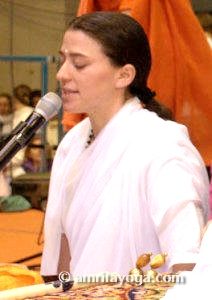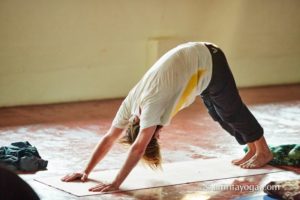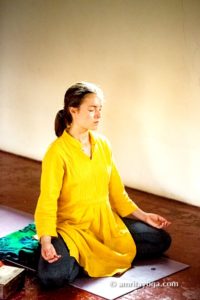
Exploring Self-Practice
You bought a yoga mat. You have the right clothes. All the holes on your yoga card have been punched. Now you unroll your mat on the floor at home. You step onto it. And…
How to practice yoga alone? What exactly is a “self-practice”? What are the benefits of practicing between classes? And how can we learn to develop a self-practice?
In Amrita Yoga, yoga is not taught as mere physical exercise; it is also a personal spiritual practice (sadhana). When students walk out the door after a course, they are equipped with the basic knowledge to deepen this practice on their own.
 The ancient scriptures tell us that our true nature is the Supreme Self, but we have forgotten this truth. Amma also reminds us that God is always with us, but we need to tune ourselves to feel that presence. All the spiritual practices taught in Amma’s ashram are tools to help us remember our true nature. Amrita Yoga is a meditative practice that reconnects us with that presence again and again.
The ancient scriptures tell us that our true nature is the Supreme Self, but we have forgotten this truth. Amma also reminds us that God is always with us, but we need to tune ourselves to feel that presence. All the spiritual practices taught in Amma’s ashram are tools to help us remember our true nature. Amrita Yoga is a meditative practice that reconnects us with that presence again and again.
 Taking classes is the first step. Clear and thorough instructions from qualified teachers are necessary to understand the yoga postures and perform them safely. At the end of each Amrita Yoga course, students are given simple handouts to help them continue practicing the postures on their own.
Taking classes is the first step. Clear and thorough instructions from qualified teachers are necessary to understand the yoga postures and perform them safely. At the end of each Amrita Yoga course, students are given simple handouts to help them continue practicing the postures on their own.
The Importance of Regular Practice
Using yoga asanas as a meditation becomes easier when practiced on a regular basis. Anything done every day becomes a meditation because the fluctuations of the mind can be more easily observed. On the first day we feel enthusiastic and energetic. Then the next morning we are bored and listless. Day three finds us restless and agitated. The yoga asanas haven’t changed at all, but our mind, it seems, has a mind of its own.
Meditation is about gaining control over our fluctuating mind. When we only practice yoga in group-classes, the controller of our mind, in a way, is the instructor. They tell us what to do, and we do it. If we are tired and the teacher says, “Move into Trikonasana,” we just do it. If we are feeling bored and the teacher says, “Stay for three more breaths,” we do it. In the class we decide to listen to the teachers, and they provide us with external support.
But when we practice alone on a regular basis, we catch the mind trying to control us! As in any meditation practice, we observe the mind. Do we plan the next pose while in the current one? Do we forget the breath when the poses are intense? Do we only perform poses that we like? Do we stop in between poses to check texts on our cell phone? Our personal yoga practice creates the perfect atmosphere to observe and still these fluctuations in the mind.
 Often people say, “I’d like to practice yoga,” or “I should meditate more,” “But… I just don’t have the discipline.” This is like Amma’s story of a man standing on the seashore with a bar of soap and a towel. A passerby asks what he is doing and the man replies, “I want to take a bath, but I’m waiting for the waves to subside.”
Often people say, “I’d like to practice yoga,” or “I should meditate more,” “But… I just don’t have the discipline.” This is like Amma’s story of a man standing on the seashore with a bar of soap and a towel. A passerby asks what he is doing and the man replies, “I want to take a bath, but I’m waiting for the waves to subside.”
The Value of Discipline
Discipline is one of the fruits of yoga practice, and any small effort helps us move forward. Amma often speaks about making short term, realistic goals that we can easily achieve. Perhaps in the beginning our aim is to practice for 10 minutes each morning. What a great goal! Each day we get together with our yoga mat and leave feeling refreshed and more centered. This develops a good habit and connects us to inner peace. As we taste these fruits of practice, we kindle a love for yoga.
Amma often speaks about the relationship between grace and effort. Grace may always be present, but we must make effort to experience it. Students of Amrita Yoga practice outside of class put forth these efforts. They also take further courses to clarify and deepen their personal practice. As time goes by, the grace of the practice begins to flow.
As Hafiz once wrote:
“Submit to a daily practice.
Your loyalty to that is a ring on the door.
Keep knocking, and the joy inside will eventually open a window
And look out to see who’s there.”
Author: Devapriya Jessicah Marks
As always, thoughtful comments are invited and appreciated. Share your reflections with us! See below to leave a comment.

0 Comments